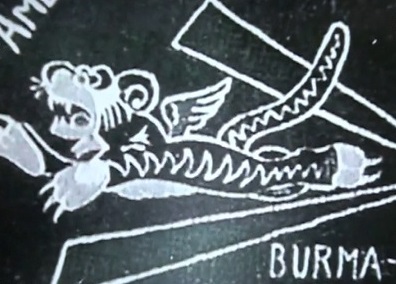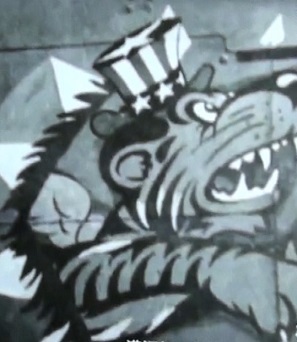cartooning in war of resistance against Japanese invasion
★ this site's world No. 1 in 2020~24, 2017~19, 2016, 2015, 2014, 2013, 2010~12 ★ top since 1998
|
|
|
|
cartooning in war of resistance against Japanese invasion ★ this site's world No. 1 in 2020~24, 2017~19, 2016, 2015, 2014, 2013, 2010~12 ★ top since 1998
|
| ★ |
| ◆ Chinese and American arts fight Fascism WWII |
| ★ |
★According to a paper "Anti-Japan War and propaganda"
in the Journal of Guangzhou University (Social
Science Edition, Jun. 2013)
- ref1, propaganda is a
decisive factor to win a modern war with national mobilization.
Since
during
the war of resistance against
Japanese invasion,
more than 80% Chinese are
illiterate
persons-
ref2, pictures,
particularly cartoons, function much
better than
complicated
Chinese words for
awakening &
promoting
patriotic
sentiments
and improving
morale.
Cartooning is a powerful weapon too. A study by Bi Ker-Guan (畢克官), the former leader of Chinese National Academy of Arts - research institute of fine-arts, and a member of the national committee of CPPCC (Chinese People's Political Consultative Committee, "政協") comments ref3 that during the war against Japanese invasion, Chinese cartoonists completely matured in the aspect of arts, thoughts, consciousness, and did make an extremely outstanding contribution to the war. In the first military strike on Japan's territory by Chinese Air Force, about one million propaganda leaflets ref4 summoning soldiers to surrender were dropped and spread to Japanese ordinary people, soldiers and warlords, those cartoons on the sheets including evoking sweet memories with their lovely women may go deep into Japanese heart, these effects and influences only can be done by cartoonists within the whole arts field. In addition to Mr. Bi's study, American cartooning ref5 also frontal attacked Japanese army, e.g., all noses of fighters of American Volunteer Group (AVG) in China led by US General Claire Lee Chennault (陳納德) were drawn with shark heads with bloody mouth and vicious-look which may scare a marine culture people. However, many landlocked nation Chinese have never seen any shark, and prefer a familiar image "flying tigers", for this, Mr. Walt Disney, the founder of Disney Land, designed a "V-sign" logo for AVG air squadrons, this Disney's tiger is flapping two wings and soaring, diving, then swooping toward the enemy troops. Another flying tiger with Uncle Sam's hat looks even more fierce. |
|
★
|
|
| ★ |
| US Cartoonists as well as US pilots gave hands to Chinese in the war of resistance against Japanese invasion. |
 |
 |
 pic.: another logo for Flying Tigers. |
||
| pic.: a large, fierce-look cartoon on all noses of fighters of American Volunteer Group. | ||||
★
Innumerable cartoons by local artists also played an important role with the aim of boosting patriotism among the Chinese people. For instance ref6 ,
Shanghai's Shun Pao (上海申報), founded by a British businessman Ernest Major since 1872, a land-mark and most social influential, longest-life newspaper in modern China, printed some cartoons depicting Chinese people's suffering hardships of weather-beaten, long-distance plodding.
In many Chinese patriotic parades, organising rallies and other public events, cartoon-drawings in large size were on the banners and posters, e.g., a furious fist is punching Japanese soldier's head, or cartoon-portraits juxtaposing Chinese leader Chiang Kai-shek with US president Roosevelt, UK PM W. Churchill, and J. Stalin, Soviet dictator, which implies China already turned into one of Big Four in the world.
Both Nationalist Party (KMT, ruling political party during WWII) and Communist Party used cartoons as propaganda tool during the anti-Japanese war. In Jin - Cha - Ji border region, communist party displayed many cartoon posters on the walls, but their official pictorial (晋察冀畫報) still mainly used photos, instead of cartoons.
《TIME Cartoon》was published as a reaction to Japan's invasion of Manchuria in 1931, which was described as a "tragic farce", according to Dr. John Lent's 《Asian Comics》.
Most "mainstream" cartoons were printed in two major cartooning periodicals ―《Jeu-Won manhua》("救亡漫畫" or namely 《Salvation Cartoons》) and 《Kang-Zhan manhua 》fortnightly periodical ("抗戰漫畫" or namely《anti-Japan Cartoons》) ref7. 《Salvation》started their publication at 9-20-1937, coming out one issue per 5 days, about 50 cartoons being collected for each copy. The author-group includes major cartoonists like Liao BingXiong(廖冰兄), Ye Chen-Yu(葉淺予1907-1995)、zhang leping(張樂平1910-1992)、Te Wei(特偉1915~ n/a)、Tsai RuoHong(蔡若虹~2002) etc. Their works mainly exposed Japanese atrocities and enhanced we-shall-overcome confidence and patriotism. The cartoon on the cover-page of the 1st publication is "violent storm and roaring waves against Japan", the heavy waves on the top are the essence of angry Chinese people, howling and staring at fiend incarnate Japanese soldiers sank beneath the waves. This cartoon reflects Chinese unprecedented determination to win the war, very coincidently, Yellow river bank breach was happened in the next year at 6-9-1938 ref8. Some studies, e.g., <The Battle of China> (1944) pointed out it's intentionally done by Chinese government to block and sink Japanese troops, although 893,303 Chinese died and 3,911,354 were homeless (China Exec. Yuan's statistics), but much less Japanese casualties and loss for this. 《Salvation》was ended after being published 12 issues, 《Kang-Zhan manhua》periodical founded by a propaganda team in WuHan city followed (1-1-1938) and printed 12 issues, the last 3 issues were published (5-15-1940) in Chongqing city and then quitted for lack of money sponsors ref9.
★
 |
|
|
|
| pic.: "The bad ending for traitors", a cartoon by Chu Yu-Tsen | pic.: Japanese army turned into a tiger being stranded. Another anti-Japan cartoon by Chu Yu-Tsen (朱育參), introduced by CTS (Chinese Television System, a major TV channel in Taiwan) in 2011. |
★
Basically speaking, most anti-Japan cartoons
are eyeball-grabbing, to the point, and
simple
ref10. For example,
a straight-forward cartoon by
International Peace Campaign - China's branch depicted a
strong manly Chinese soldier contrasting
two
ape-look escaping Japanese.
Many others are graphic news-reports, publicizing
latest fighting status
at the front as well as in the rear, and some miserable sights or
Japanese atrocities
being directly witnessed, a cartoon exhibition in Nan-Jing's theater
attracted 20,000 person per day, the most touching one there is a bloody baby reclining
its mother just died for Japan's bombing still kept mom's nipple in its mouth. To think aesthetically, although
many of them already developed
excellent drawing skills and style, as well as applied
arts elements like analogy,
contrast, exaggeration, but
only a few are boundless imaginative, witty
or clever cartoons, e.g., Hua JunWu(華君武) applied
metaphor, literal similarity,
and mere appearance to depict snow men (Japanese army) will melt soon after the sun-rise
(Japanese nation's emblem), and Republic of China's star emblem became ripples on the water.
Hua's using remote but associated elements to convey core
messages, and unexpected but within-reason surprises to impress readers.
Another
cartoon by Liao
BingXiong compared Chinese with a sharp knife rooted in land so that Japanese
failed to pull it down, about 50 years later, a
cartoon illustration in TIME (Feb.,1990) drew an ax rooted
in land have burgeoned forth.
Cartooning propaganda were also conducted overseas in Hong Kong by pictorial <China Today> (今日中國) and in Moscow by 45 pieces cartoon-exhibition (Jun. 1938), etc ref11. In 2011, CTS, a major TV channel in Taiwan ref12, introduced a number of cartoons by Chu Yu-Tsen (朱育參), published in Malaysia in world war II, some shows the use of fear messages, which was rarely seen in Chinese anti-Japan cartoons. One fear-based cartoon produced a variation on a well-known image from the past ―― the most notorious Chinese traitor Qin Hui (1090-1155 AD) kneels to the grave of the most devoted & loyal Chinese general Yue Fei (岳飛), to arouse all potential traitors the emotion of fear ― all their families will be condemned as a sinner through the ages. Papers proved Intimidation usually is an effective and persuasive means, e.g., UK's propaganda "Daddy, what did you do in the war". Chu's cartoon also trap the target audiences brain's "dictionary search"ref13 so as to be impressive, and those unspecific faces alarm that the potential traitors could be anyone around you. Compared another often-seen cartoon , "a burning sun", which contrasts three rich traitors with a hard-working farmer, it shows a happy life led by traitors so as to possibly encourage more Chinese surrendering to Japan.
Anti-fascism cartoons continued in today's Taiwan, Zola Zu, Federation of Cartoonists Organisation president of Taiwan, had some anti-Japan and anti-fascism cartoons been published in the United Daily News system of Taiwan, his Courage World cartoon exhibition kept displaying some anti-fascism cartoons there. Best-known cartoonist Ron Chu's humor-and-satire cartoon albums, e.g., <漏電篇>, <大刺蝟>, include a number of gag cartoons mocking warmongers and their political tricks.
"Hitler resurgence" is not, and should not be welcomed by Taiwanese as well as by the entire world.
★
|
|
|
|
|
References
● ref 《Asian Comics》, University Press of Mississippi, Dr. John A Lent, 2015.
● ref1
"抗战与宣传_以国际反侵略运动大会中国分会的战时宣传为例" ( the Journal of Guangzhou University - Social Science Edition, Jun. 2013), by Liu Z. N.(刘宗灵), Sichuan University, Xia Y.(夏炎), University of Electronic Science and Technology of China.
http://www.nssd.org/articles/article_detail.aspx?id=46999335 (National Social Science Database)
http://wenku.baidu.com/view/ce1a605a192e45361066f5b3.html?re=view (Baidu)
● ref2 Documentary Channel (纪实频道) , Shanghai Television (STV)
《 满江红:抗战珍稀影像全纪录》(Man Jiang Hong - rare imges, sk collection in Anti-Japanese War, issues 1 ~ 10 ), first broadcasted in Phoenix Television (凤凰卫视) at 3-7-2011.
● ref3 The Academy of Chinese Studies (中國文化研究院 http://www.cns.org.hk/ )
http://www.chiculture.net/20504/html/c09/20504c09.html#nogo
● ref4 Oriental Morning Post (東方早報), 8-7-2014, <抗日漫畫宣傳隊的烽火歲月> 1~3, by Huang Ko (黃可), http://history.people.com.cn/BIG5/n/2014/0807/c372327-25423803.html
At 5-19-1938 the Chinese Air Force from WuHan dropped 2 million propaganda leaflets including articles and cartoons in Kyushu, Japan.
● ref5, ref6
Documentary Channel (纪实频道) , Shanghai Television (STV)
《 满江红:抗战珍稀影像全纪录》 (Man Jiang Hong - rare imges, sk collection in Anti-Japanese War, 1 ~ 10), first broadcasted in Phoenix Television (凤凰卫视) at 3-7-2011.
● ref7
(1) The Academy of Chinese Studies (中國文化研究院) http://hk.chiculture.net/ http://www.cns.org.hk/
http://www.chiculture.net/20504/html/c09/20504c09.html
http://www.chiculture.net/20504/flash/zlt/zlt.html
(2) NewsCartoon.com.cn (中國新聞漫畫網)
http://www.newscartoon.com.cn/focusview.shtml?fid=192
● ref8
Wikipedia
https://zh.wikipedia.org/wiki/%E8%8A%B1%E5%9B%AD%E5%8F%A3%E5%86%B3%E5%A0%A4%E4%BA%8B%E4%BB%B6
● ref9
(1) Xinmin Evening News (新民晚报), 8-25-2015
"诞生在抗日烽火中的《抗战漫画》" by Liu Xen. Wen (刘善文)
(2) Art ifeng, Aug. 25, 2015, http://art.ifeng.com/2015/0825/2488575.shtml
● ref10
The Academy of Chinese Studies (中國文化研究院) http://hk.chiculture.net/ http://www.cns.org.hk/
(1) http://www.chiculture.net/20504/html/c09/20504c09.html
(2) http://www.chiculture.net/20504/flash/zlt/zlt.html
● ref11
Oriental Morning
Post (東方早報), 8-7-2014, <抗日漫畫宣傳隊的烽火歲月>
No.2, by Huang Ko (黃可)
http://history.people.com.cn/BIG5/n/2014/0807/c372327-25423803.html
● ref12
China Television System (CTS), News Magazine, Aug. 2011
http://event.cts.com.tw/news/newsmag/
●
ref13
Visual Persuasion: The Role of Images in Advertising , by Paul Messaris , SAGE Publications, '97